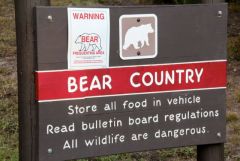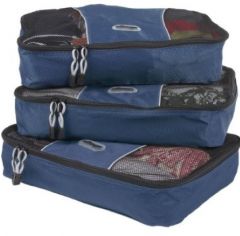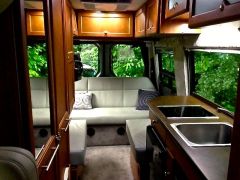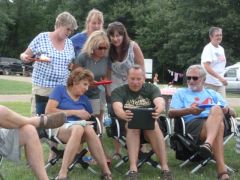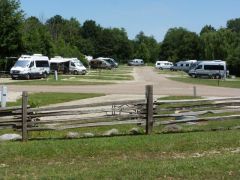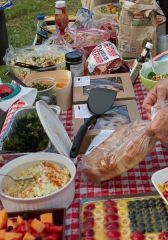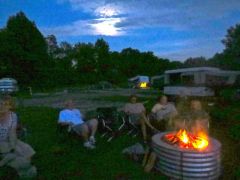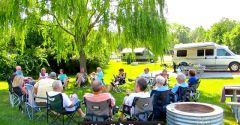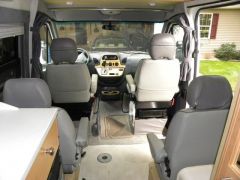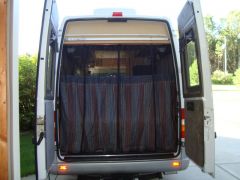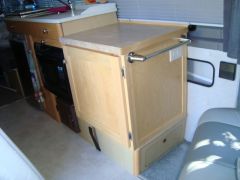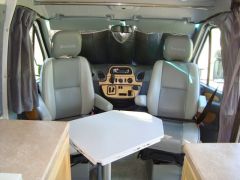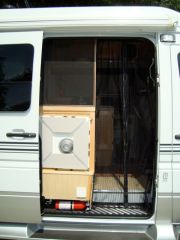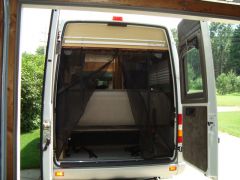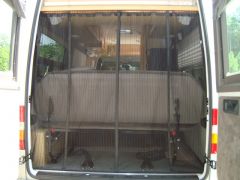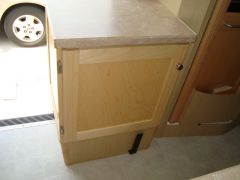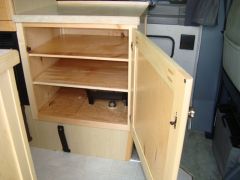-
Content Count
669 -
Joined
-
Last visited
-
Days Won
17
Content Type
Profiles
Forums
Blogs
Gallery
Everything posted by Roadtrekingmike
-
From the album: RVing and Camping in Bear Country
A grizzly bear. I took this photo at the Wolf and Grizzly Discovery Center in West Yellowstone, Wyoming -
From the album: RVing and Camping in Bear Country
Most wilderness campgrounds will have warning signs like this bears are in the area. I shot this during a recent visit to Yellowstone National Park. -
I’ve switched smartphones and it’s all because of RVing. I now use the Samsung Galaxy S 4. I traded my iPhone 5 in at my local Verizon store and now am tasked with learning a new system. I feel a little guilty about it. I have been told that the iPhone I bought at 6PM EST on June 29, 2007 was the first one sold. It was part of a TV live shot I was doing and I had stood all night long, first in a long line. Working with the manager of at AT&T store, we arranged for me to be standing at the counter and my credit card was processed at 6:00:08. Regardless, I have loyally bought and used every iPhone since then. But over the past year, as innovation with the Android operating system began to ellipse Apple’s, I began to have smartphone envy as I saw some of the many features available on newer models. The Galaxy S 4, with it’s much larger screen and 13 megapixel camera (compared to the iPhone’s 8 megapixels), was an immediate draw. Add to that wireless charging, a much tougher glass display, 2GB of RAM (double the iPhone’s) and a faster CPU and slightly more apps than Apple has and the appeal was very strong. Probably the final straw for me was my iPhone battery was starting to fail. A full charge only lasted half a day. But the battery on the iPhone is not user accessible. I had to send to to Apple to be replaced. What a needless hassle. The battery on the Galaxy S 4 can be easily replaced by the user. Even though a new version of the iPhone will be coming by Christmas, it’s not here yet. The Galaxy S 4 has all these features I want now. The decision was made. I rely on my smartphone more than ever because of all the RV traveling I do. I especially like the Allstays Camp and RV – All Campgrounds app. Yes, I know, there is an iPhone version of it. But because I use this app so often to find Walmart’s, campgrounds, dump stations and the like, I found myself squinting at the iPhone screen a lot. It’s much easier to read on a Galaxy. I’ll write more about my favorite RV apps in a later post. I use my smartphone all the time. For email from readers of this blog. To update our Facebook Page and Facebook Group. To tweet updates on Twitter. To take and share photos and video and to stay in touch with news while traveling. I also travel with an iPad but, truthfully, it’s a bit too big for me while on the go. Jennifer may use it for checking maps but we prefer the smartphone for convenience. So my iPhone is gone. Jennifer still has hers. But I’m spending the next couple days getting used to the Galaxy and the Android operating system and enjoying the learning process. I love playing with tech gizmos. One of the coolest things is the way the Galaxy 4 lets you wave your hand at the screen to accept calls with Air Gesture, read content by tilting your head or phone with Smart Scroll and preview content by barely touching the screen with Air View. It can be touch free. I’ll put the new smartphone to good use starting next week when we head west on another RV adventure. Meantime, how do you use your smartphone?
-
-
From the album: How to Unclutter Your RV
Jennifer folding up the RV Superbag -
From the album: How to Unclutter Your RV
The ebags -
From the album: How to Unclutter Your RV
Neat and uncluttered. A place for everything and everything in its place -
We have discovered he one all important guiding principle that more than anything determines the success or failure of an RV trip: There needs to be a place for everything and everything should be in its place. When we first began our RV travels, we took everything. Sometimes two of everything. Both Jennifer and I were so paranoid that we left something behind that we overcompensated. Our little 24 foot Class B RV looked like a scene out of that Hoarders reality TV show, you know, the one where people life in houses so cluttered that they had to make tunnels to move between the piles of junk. We took too much food, too many clothes, too many folding chairs, too many pots, pans and utensils. I had tools of every size and shape, fishing stuff, two bicycles, snorkeling gear, beach towels, workout bags, a pile of books and all my computer, video and camera gear. We were bloated. It didn’t take long to realize that we were overcompensating for our lack of RV experience by overpacking. It took forever to load the RV for a trip and even longer to haul everything out when we returned home. Here’s how we uncluttered. The kitchen – We now take two plates, two cups, two glasses (plastic) and, on the rare occasions when you may have a guest, some paper plates. Same with utensils, which are supplemented by some plastic spoons, forks and knives. You don’t need place settings for six. As far as pots and pans, we bring one of each. We bring a small electric frying pan for cooking bacon and pancakes and a George Forman grill. We have a very small charcoal grill we sometimes pack in the storage area at the back. I have a small K-cup coffee maker. Food – The staples are pretty basic. Some olive oil, a jar of peanut butter, jam, bread, granola, yogurt, butter, crackers, cheese, meat, some fruit and some snacks. We eat a lot of salads. Jennifer will prepack the fixings in a zip lock bag at home and bring them. We take no more than a three day supply of food. Its easy and fun to shop locally on the road, getting fresh fruits and veggies. And we do eat out at local restaurants a lot. There is no better way to know an area than to eat where the locals do. We take along a case of bottled water, too, keeping it on one side of the bottom of an armoire we had installed. Clothing – We permanently keep jackets, sweats and one good outfit in the wardrobe closet. We bring sandals, hiking boots and a presentable pair of slip ons. Jennifer also brings house slippers. We keep them on the other side of the armoire bottom. We have both come to really appreciate the small little packing cubes called eBags. Click that link to see Jennifer demo them. We each bring two, mine is blue, Jen’s is red. We easily can get a five day supply of all the clothes we need in them. They fit in a rear overhead cabinet on the driver’s side of the coach. Hygiene and shower items – We permanently leave soap, bathroom supplies, hair brushes, toothbrushes and the like in the bathroom. A surprising amount fits in that pull out drawer. I found a little plastic dish and holder set that attaches to the wall above the sink by a suction cup to store bath items. I also have a small knapsack that has extra soap and shampoo and a pair of flip flops that I carry when using a shower at a campground bathhouse. It goes in with the shoes in the armoire for storage. Jennifer has a large tote bag with her stuff that also fits in the armoire. Bedding – We make our coach bed up into a king bed each night and put a four inch mattress topper on it that we picked up at Bed, Bath & Beyond a year or so ago. It is more comfortable than our Sleep Number bed at home. On top of that we put on the RV Superbag. Click that link and you’ll see Jennifer demonstrate it. It has a summer side, a winer side and luxuriously comfortable sheets that attach inside by Velcro. It’s expensive. But we have found it incredible comfortable. We keep the topper in the top storage cabinet across the back of our Roadtrek eTrek. It’s a tight squeeze but it fits. The RV Superbag is rolled up and goes in the armoire. We make up the bed each night and then put it away after we wake up. We like having the back area as a sofa/lounging area during the day. Tools – In the rear storage area beneath the bed, I carry one small toolbox. In it are screwdrivers, pliers, a small hatchet that can double as a hammer, duct take, a tube of sealant, a small bottle of Gorilla glue, scissors, a good pocketknife and probably some other little odds and ends. I keep the water hoses (two rolls of 25-foot white hose), electric hook up cables (two 25-foot lengths), a 50 to 30 amp adapter, a 25 foot 15-amp extension cord , a pair of gloves and my water filter in a large plastic storage bin I got at Lowes. Also in the back are some of those Lego-like leveling blocks, a fishing pole and small plastic tackle box, a ground cover for the patio area outside the sliding door, a small fold-up table and two Pico telescoping outdoor chairs. Computer and Photo gear – Basically, my still and video cameras, wireless microphones and their respective chargers and accessories all go in one large bag. It fits in the armoire. I have a backpack for my computer gear that fits atop the bag in the same place. I bring several very small, collapsible tripods. Storage drawer – In the armoire s a small storage drawer. In it I have flashlights, extra fuses, a small screwdriver with the square head used for most of the screws in my Roadtrek, a small pair of walkie-talkie two-way radios, pens, maps and little things. So that’s what we take with us. We leave as much as possible inside the coach when we’re home so we don’t have to keep loading and reloading the same things. Instead of a pile of books, we read them from Kindle on the iPad. We only take the bicycles when we know we’ll be doing a lot of cycling. Snorkel gear stays home, unless we absolutely know we will be snorkeling. Just because we could use it doesn’t meet the test we have set up for what to bring and what to leave: Take only what you are sure you will need. If in doubt, leave it home. Something else that is important that, if not adhered to, can really clutter up your RV: Don’t buy a lot of souvenirs while on the road. If you must, consider shipping such purchases to your home. If that’s not possible, make sure you have room for them to be stored away out of sight. When we are traveling, we have a rule that we both stick to religiously. When we are finished using it, we put it away. We always put it in the same place. I can’t over-emphasize the importance of that. I bought a bunch of stick-on hooks that I have affixed to various walls around the coach. We use them for sweatshirts, hats and the like. At night, we each have one hook that we use to hang the clothing we’ll put on the next morning. Everything has a place, and everything goes in that place and that place only. Organizational experts say that you should go through your home closet every year. Anything you haven’t used in the last six months should be discarded. When it comes to an RV, anything you didn’t use on your past trip should probably not be brought along on the next one. That’s our system, what works for us. I suppose it’s a reflection of our personality. Neither one of us can stand clutter. And with each trip, things seem to get more streamlined. I’d love to hear how you have uncluttered your RV. Use comments below to share.
-
-
From the album: An RV Gathering of Friends
Skyping a visit with one of our RV friends recovering from knee replacement surgery -
From the album: An RV Gathering of Friends
Some of the Class B Roadtrek motorhomes at our gathering -
From the album: An RV Gathering of Friends
That was one pretty moon we gathered under. -
From the album: An RV Gathering of Friends
There was no danger of running out of food. -
From the album: An RV Gathering of Friends
Thumbs up for Ketchup Flavored Potato Chips, imported from Canada -
From the album: An RV Gathering of Friends
There was lots of talk under a full moon and around a campfire. -
From the album: An RV Gathering of Friends
We gathered at Addison Oaks Campground in Oakland County, Mich. -
Please do not call it a rally. There was no itinerary. No organized programs. And no nametags. We all made our own reservations and the only coordinated planning was letting the word out on our Roadtreking Facebook Group that a bunch of us were going to meet on a particular weekend at a particular campground in Michigan. It was more fun than any of us expected and a great example that great RVing times can be spontaneous and as easy as just showing up and getting together. In all 10 coaches pulled into the Addison Oaks Campground in Oakland County, Michigan. We had 20 people show up, from Michigan, Ohio, Missouri, New York and Ontario, Canada. Many of us knew each other from either Facebook or the Roadtrek rally in May in Branson, MO. So in that sense, this gathering was more of a reunion than a rally. Maybe a better word is rendezvous. Whatever it was, it was very good. We mostly just chilled, forming a huge circle of chairs in the shade of a willow tree. On Saturday afternoon, a half dozen or so headed into nearby Rochester, MI to take advantage of a Farmer’s Market and a gourmet food shop. We all brought our own food, but shared a dish at dinnertime. At a time when there is so much polarization in our culture, our group was warm, welcoming and harmonious, despite the fact that we are all over the place politically. Some were conservative, others liberal. Some were religious or spiritual, others agnostic. Those differences were not important. What bound us together was our love for travel, particularly travel in small motorhomes. One couple was on their very first camping trip in their new motorhome. Another couple had covered over 20,000 miles in their Roadtrek Class B coach just since January. We laughed a lot and shared stories of our adventures and just hung out together. One of our friends, Lisa Gruner from Huntsville, AL, was recovering from a knee replacement surgery. So since she couldn’t be physically in our circle, we Skyped her from our circle of chairs. But what amazed me the most was what we learned about each other when we visited around the campfire. In our midst were nature photographers, boaters, a model train hobbyist, a couple of golfers, a knitter, a basket weaver, a fitness fanatic, Scuba divers, cyclists, fishing lure makers, a family liaison volunteer for a U.S. Marine battalion in Afghanistan, a master gardener, a beekeeper and a very busy community volunteer. And that’s what hit me about this group: Though we ranged in age from the mid-50s to near 70, some were retired, others still working, everyone was extremely active and connected. And that’s why we all chose our Class B small motorhomes. Because we like to be on the move and on the go once we get wherever we’re going, hiking, kayaking, exploring. Except for this weekend. This weekend was a time to enjoy each other’s company. I came away with three takeaways from this weekend. 1 – RV gatherings need not be complicated. Just announce a time and place and people will come. You can send emails, post to Facebook or pick up the phone and call people but that’s about as organized as you have to be. I’d say 20 people is about as big as you want. Any larger and it will be hard to get to know everyone. 2 – Social media is great. But nothing is as fulfilling as connecting with people as real face time. There is something very satisfying about getting to know someone shoulder to shoulder. 3 – We are all much too busy. Even when we RV, we spend a lot of time rushing from place to place, sight to sight, campsite to campsite. Sometimes, it’s very good to just stop, sit and chat for a spell. That’s what 20 of us did this weekend. I didn’t know everyone when we first met Friday night. But when we all returned to our homes Sunday, we left as very special friends. I’m betting there will be a reunion of our reunion.
-
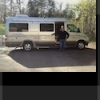
7 tips for using your Class B RV as an everyday vehicle
Roadtrekingmike posted a blog entry in Roadtreking Blog
One of the great things about having a Class B RV like our Roadtrek eTrek is that it also can function as a second vehicle. I’ve used it to run errands, drive to and from meetings and work-related activities, church and – while Jennifer is shopping – a comfortable place to chill out while in the parking lot of the mall. I’ve also used it for what I call mini-vacations, short day trip respites of a few hours to parks, lakeshores and the like. Sometimes, I’ve put the bike rack on, drove to a big metropark near my house, done a long bike ride and then just chilled out for a few hours. Traveling around with a refrigerator stocked with cold refreshments, some snacks and food in the pantry, a TV and DVD and , of course, a full bathroom, is sure something we can’t do in the family SUV. Best yet, my Roadtrek eTrek gives me better fuel mileage than the SUV does. If you’ve been thinking about using your RV as a second vehicle, here are my top seven tips to make it easy. 1- Be aware of your surroundings. Your RV is not only longer than most other vehicles, it’s taller, too. Look for low hanging limbs, utility wires, signs and the like. Don’t even think about parking garages. Yes, it can go just about anywhere. But it is not a car. I was using an alley that paralleled the main street of a downtown near my home the other day and would have taken out a whole string of overhead wires that were sagging low in the summer heat. Cars easily passed beneath them. My 10-foot high coach would have not been able to Limbo underneath them. 2- In parking lots, choose the spaces that are at the ends of the lot, with nothing behind them except maybe a curb or six inch parking barrier. I always prefer to back in. Because the rear wheels of my Sprinter chassis are set back from the actual end of the coach I can back in a long way, until the wheels hit the barrier, I only stick out a little longer than the other vehicles next to me. 3- Watch out for very steep driveways. Most Class Bs have a lot of stuff hanging off the rear. They are also longer. And thus steep driveways pose the risk of bumping or scraping your generator or hot water heater or, in the case of the eTrek, the battery holders. 4- Be considerate. I seldom park horizontally on city streets. Yes, maybe, in some spots, I really can squeeze between the lines. But for those in front or behind me, it will be very challenging for them to get out. Or me, too, for that matter, should you be hemmed in at both ends. Similarly, don’t run your generator in crowded areas where the noise can really irritate folks. 5- Watch out for potholes and broken pavement. City streets can be pretty messed up. And those streets can mess up your RV. A car can rattle over them pretty fast. A Class B RV sways and porpoises. Cabinets can pop open (don’t ask Jennifer about the stack of plates I broke on one such urban adventure). Bad roads are particularly bad for RVs when making sharp turns. Always take turns slowly at corners. 6- Lock you RV. That seems pretty obvious, I know. But thieves know motorhomes are very expensive and thus, chances are they have expensive things inside them, too. Just as you probably have a security system for your family car, get one for your RV. Don’t leave your GPS suction cupped to your windshield. If you’re charging computers, cameras or cell phones inside the RV, hide them so no one can see be peering into a window. Think the inside is invisible because of window tinting? Think again. Put your face up to the glass and put a hand over your eyebrows to block reflection. You’ll learn that you can see pretty good. 7- Be polite. You are an ambassador for roadtreking…for Class B RVing. The public is very curious about small motorhomes. It’s a very rare day that I am not asked about mine when I am in the city or a big parking lot. We gladly give tours. You don’t have to do that. But don’t be a snob, either. If you don’t want to talk about it, don’t drive it where people will naturally be attracted to it. There you go. What would you add to the above list? -

Stormy Kromer hats: A Yooper tradition develops a cult-like following
Roadtrekingmike posted a blog entry in Roadtreking Blog
I’m a sucker for hats. Ball caps, cowboy hats, straw hats, watch caps and lately, Stormy Kromer hats. We picked up our first Stormy Kromer hats while doing some winter camping last February in Michigan’s Upper Peninsula. Seemed like every Yooper we saw was wearing one. So Jennifer and I both got one, me a rakish black, Jennifer’s a demure grey with pink trim. As we returned from that trip but kept wearing our hats, we met lots of other people who either had one, knew someone who had one or wanted one. Lots of people call them an Elmer Fudd hat. Don’t do that. This is a Stormy Kromer hat, steeped in UP tradition. Here’s the official story, from the Stormy Kromer website: George “Stormy” Kromer was a real guy – a semi-pro baseball player and railroad engineer. Not the kind of guy you’d expect to start a clothing company, in other words, but one who happened to create a cap that became known for long-comfort and the ability to stay snug, even in the fiercest winds. This final feature, in fact, is the reason he made his famous headgear in the first place, but we’ll get to that in a bit. Mr. Kromer, known as “Stormy” to the folks who knew his temper, was born in 1876 in Kaukauna, Wisconsin. He grew up with baseball and would eventually play on nearly 30 semi-pro teams throughout the Midwest. He might have continued to play that field, too, but he met Ida, and before Ida’s father would allow her hand in marriage, our ballplayer needed to find real work. That meant the Chicago & Northwestern Railroad and long, cold trips across the plains. Stormy was an engineer, and to see where he was headed, he had to stick his head out the window – into the wind. Mother Nature stole his cap more than once, and as the story goes, he set out to get her back. In 1903, he asked Ida (now his wife and an excellent seamstress) to modify an old baseball cap to help keep it on in windy weather. The all-cloth cap with the soft, canvas visor was a departure from the traditional fedoras of the day, but it was more comfortable and because of its six-panel fit, it stayed put. Soon other railroad workers wanted one of Stormy Kromer’s caps for themselves, and when Ida could no longer keep up with demand, they hired a few employees and the business was born. A lot of things have changed since those first few caps – new colors, new fabrics, new styles – but we haven’t changed the way we make ‘em. They’re hand-stitched right here in the good old U-S-of-A, and they’re still made to fit better than anything you’ve had next to your noggin. Stormy Kromer caps are true to the original, and that means you get all the comfort and function that made them famous. Wear one, and you’ll know what we mean. I was going to do a Stormy Kromer story in February, when we got our hats. But I decided to hold off until I could visit the actual factory where they were made, in Ironwood, at the far western end of the UP, right on the Wisconsin border. So when we were there on our annual RV tour of the UP, I made an appointment with Bob Jacquart, the CEO, and arranged for a factory tour. Again, from the website: In 2001, Bob Jacquart (CEO of Jacquart Fabric Products, in Ironwood, Michigan) got wind that the Kromer Cap Company in Milwaukee, Wisconsin, was about to discontinue production of its legendary Blizzard Cap. Bob had a mind to make a call to Milwaukee and see if he couldn’t make those quirky wool caps a part of his sewing factory. A month later, Bob was the proud new owner of the Kromer Blizzard Cap, and Ironwood officially became home to the legend it had always struck a certain sentimental claim to. You see, folks in Ironwood (and the rest of the U.P.) have been wearing Kromer caps for generations, and it seems this has always been their true home, where the North Wind blows cold and the snow falls harder than almost anywhere else. When the cap came to Ironwood, Bob made a few subtle changes to the iconic headgear, changing the name from the Kromer Blizzard Cap to the Stormy Kromer Cap, and adding Stormy’s signature and the founding date to the back of every cap. Over the next 10 years, Bob invested in Stormy Kromer – particularly through branding and marketing – and today, annual production of the caps is 20 times what it was in 2001. Bob and his crew have also expanded the product line significantly – adding outerwear, apparel, and a full women’s line in honor of the debt we all owe Ida for creating this winter masterpiece.Today, Stormy Kromer products are still hand-stitched in the U.S. of A. It might be cheaper to sew things overseas, but it just wouldn’t feel right. That’s why every piece of Stormy Kromer gear is hand-crafted in America from the finest fabrics on earth. That not only makes for a legendary cap or article of clothing, it means the hundreds of hard-working folks we employ in the heartland get to keep working hard. And if that’s the style of authenticity you’re looking for, well, you just found the perfect fit. The hats have really become cult items. Hollywood and rock stars wear them. They're showing up in trendy magazines, and a new marketing campaign is about to make them even better known. The Stormy Kromer factory in Ironwood welcomes tours. Just stop in next time you are through the area. A wall of photos tells the history and story of this cool hat. You can watch the Yooper ladies in the sewing room assembling the hats. And afterwards, shop a retail area of the factory to get your own. And yes, I got a new Stormy Kromer, a light weight summer tan. You can see it at the end of my video. Stormy Kromer rocks! -

Cool Modifications to a Roadtrek: Screens and Cabinets
Roadtrekingmike added images to a gallery album in Members Gallery
-
From the album: Cool Modifications to a Roadtrek: Screens and Cabinets
With rear captain’s chairs installed -
From the album: Cool Modifications to a Roadtrek: Screens and Cabinets
Privacy curtain -
From the album: Cool Modifications to a Roadtrek: Screens and Cabinets
Cabinet on driver’s side -
From the album: Cool Modifications to a Roadtrek: Screens and Cabinets
Table in place -
From the album: Cool Modifications to a Roadtrek: Screens and Cabinets
Sliding door screens



